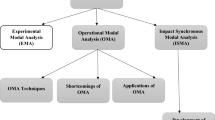Abstract
Generalized independent coordinates are typically utilized within an analytical dynamics framework to model the motion of structural and mechanical engineering systems. Nevertheless, for complex systems, such as multi-body structures, an explicit formulation of the equations of motion by utilizing generalized, independent, coordinates can be a daunting task. In this regard, employing a set of redundant coordinates can facilitate the formulation of the governing dynamics equations. In this setting, however, standard response analysis techniques cannot be applied in a straightforward manner. For instance, defining and determining a transfer function within a frequency domain response analysis framework is challenging due to the presence of singular matrices, and thus, the machinery of generalized matrix inverses needs to be employed. An efficient frequency domain response analysis methodology for structural dynamical systems modeled via dependent coordinates is developed herein. This is done by resorting to the Moore–Penrose generalized matrix inverse in conjunction with a recently proposed extended modal analysis treatment. It is shown that not only the formulation is efficient in drastically reducing the computational cost when compared to a straightforward numerical evaluation of the involved generalized inverses, but also facilitates the derivation and implementation of the celebrated random vibration input–output frequency domain relationship between the excitation and the response power spectrum matrices. The validity of the methodology is demonstrated by considering a multi-degree-of-freedom shear type structure and a multi-body structural system as numerical examples.






Similar content being viewed by others
References
Clough RW, Penzien J (1993) Dynamics of structures. McGraw Hill Inc, New York
Udwadia FE, Phohomsiri P (2006) Explicit equations of motion for constrained mechanical systems with singular mass matrices and applications to multi-body dynamics. Proc R Soc A 462(2071):2097–2117
Antoniou EN, Pantelous AA, Kougioumtzoglou IA, Pirrotta A (2017) Response determination of linear dynamical systems with singular matrices: a polynomial matrix theory approach. Appl Math Model 42:423–440
Kougioumtzoglou I, Fragkoulis V, Pantelous A, Pirrotta A (2017) Random vibration of linear and nonlinear structural systems with singular matrices: a frequency domain approach. J Sound Vib 404:84–101
Moysis L, Pantelous AA, Antoniou E, Karampetakis NP (2017) Closed form solution for the equations of motion for constrained linear mechanical systems and generalizations: an algebraic approach. J Frankl Inst 354(3):1421–1445
Pantelous A, Pirrotta A (2017) Modal analysis of multi-degree-of-freedom systems with singular matrices: analytical dynamics approach. ASCE J Eng Mech 143(6):06017005–06017007
Roberts JB, Spanos PD (2003) Random vibration and statistical linearization. Dover Publications, New York
Lanczos C (1986) The variational principles of mechanics, 4th edn. Dover, New York
Paz M, Leigh W (2004) Structural dynamics: Theory and Computation. Springer, Berlin
Schutte AD, Udwadia FE (2011) New approach to the modeling of complex multi-body dynamical systems. J Appl Mech 78(2):021018
Fragkoulis VC, Kougioumtzoglou IA, Pantelous AA (2016) Linear random vibration of structural systems with singular matrices. ASCE J Eng Mech 142(2):04015081
Fragkoulis VC, Kougioumtzoglou IA, Pantelous AA (2016) Statistical linearization of nonlinear structural systems with singular matrices. ASCE J Eng Mech 142(9):04016063
Campbell SL Meyer, Jr CD (1979) Generalized inverses of linear transformations. Dover Publications, New York
Ben-Israel A, Greville TNE (2003) Generalized inverses: theory and applications, 2nd edn. Springer, New York
Author information
Authors and Affiliations
Corresponding author
Additional information
Publisher's Note
Springer Nature remains neutral with regard to jurisdictional claims in published maps and institutional affiliations.
Appendix
Appendix
1.1 Moore–Penrose theory elements
In this Appendix, some elements of the generalized matrix inverse theory pertaining to the Moore–Penrose (M–P) matrix inverse are provided for completeness [13, 14].
Definition: If \( {\mathbf{A}} \in {\mathbb{C}}^{m\,x\,l} \, \) then \( {\mathbf{A}}^{ + } \, \) is the unique matrix in \( {\mathbb{C}}^{l\,x\,m} \, \) so that
The matrix \( {\mathbf{A}}^{ + } \, \) is known as the M-P inverse of \( {\mathbf{A}} \) and satisfies all Eq. (29). In general, the M-P inverse of a square matrix exists for any arbitrary \( {\mathbf{A}} \in {\mathbb{C}}^{m\,x\,m} \, \), and if \( {\mathbf{A}} \) is non-singular, \( {\mathbf{A}}^{ + } \, \) coincides with \( {\mathbf{A}}^{ - 1} \). Further, the M-P inverse of any m x l matrix \( {\mathbf{A}} \) can be determined, for instance, via a number of recursive formulae (e.g., [13, 14]), and provides a tool for solving equations of the form
where \( {\mathbf{A}} \) is a rectangular (m x l) matrix, \( {\mathbf{x}} \) is an l vector and \( {\mathbf{b}} \) is an m vector. For a singular square matrix \( {\mathbf{A}} \), utilizing the M-P inverse, Eq. (2) yields
where y is an arbitrary n vector and \( {\mathbf{I}} \) is the identity matrix.
Rights and permissions
About this article
Cite this article
Pirrotta, A., Kougioumtzoglou, I.A. & Pantelous, A.A. Stochastic response determination of structural systems modeled via dependent coordinates: a frequency domain treatment based on generalized modal analysis. Meccanica 54, 1421–1431 (2019). https://doi.org/10.1007/s11012-019-00963-y
Received:
Accepted:
Published:
Issue Date:
DOI: https://doi.org/10.1007/s11012-019-00963-y




